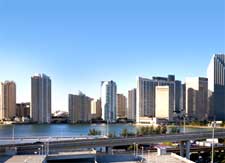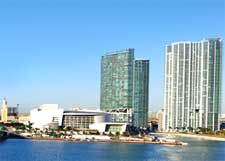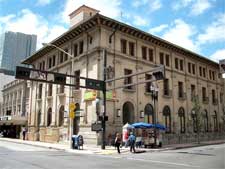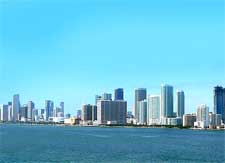Miami History Facts and Timeline
(Miami, Florida - FL, USA)

The local hunting and gathering Tequesta tribe were eradicated, like so many other native civilizations, when Spanish explorers first landed in Florida in 1513.
The history of Miami was further defined when a 2,000-year-old circle of 24 bedrock holes in the middle of this bustling city was discovered as recently as 1998. This 'Miami Circle' is not only one of the oldest permanent structures on America's east coast, but one of the few surviving reminders of the South Florida city's oldest known civilization.
Spanish Settlement History
A 1567 Spanish mission and a 1743 fort were among the few significant buildings at the Miami River's mouth for several centuries. During these years, most visitors were treasure hunters from the Bahamas and most residents were Spanish farmers, who in turn sold land to many of these sailors. One of these settlers, Richard Fitzpatrick, established Fort Dallas on his North Miami River plantation in 1836.

Second Seminole War
Shortly before Florida achieved American statehood in 1821, the area was a refuge for runaway slaves and Seminole Indians. Fort Dallas became a major battlefield in the devastating Second Seminole War, which killed virtually all of the native population between 1835 and 1842.
After the war ended, William English, Fitzpatrick's nephew, resurrected the original plantation as the village of Miami. Between 1855 and 1858, the Third Seminole War, although less devastating than the second, kept the community's population small well into 19th-century Miami history.

The Expanding City
An 1895 freeze that destroyed northern Florida crops helped citrus grower Julia Tuttle persuade railroad man Henry Flagler to expand his rail line further south. The following year, the new city of Miami became the only one in the United States to be founded by a woman.
Although Miami's permanent population was just over 300, its number of rich and famous visitors increased dramatically after the legendary five-floor Royal Palm Hotel first opened its doors in 1897. Jewish merchants and black laborers from the Bahamas and other parts of the United States helped to increase the city's overall size and population even further. The famous Miami Beach was created from a sandbar laying beneath Biscayne Bay, before a bridge was built here in 1913.

The Magic City
It took some ten percent of the overall population to build the Vizcaya Museum and Gardens, one of numerous stately vacation homes along the famous Millionaire's Row. A hurricane, a land boom collapse and the Great Depression weakened Miami during the 1930s, but the city boomed once again during WWII thanks to its southern port.
The culture of the Cuban refugees who first flocked to Miami during Fidel Castro's rise to power remains dominant in the city today. With a 70 percent Hispanic population, Miami is now considered Latin America's unofficial capital. It took just over a century in history for it to expand from a tiny village of 300 to a sprawling urban metropolis of more than 5.5 million people.
 The local hunting and gathering Tequesta tribe were eradicated, like so many other native civilizations, when Spanish explorers first landed in Florida in 1513.
The local hunting and gathering Tequesta tribe were eradicated, like so many other native civilizations, when Spanish explorers first landed in Florida in 1513.

